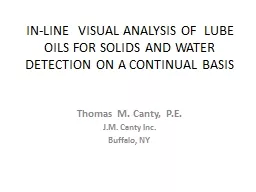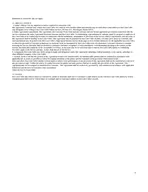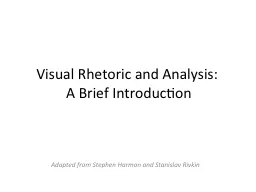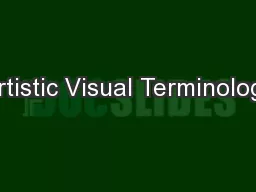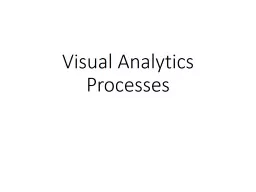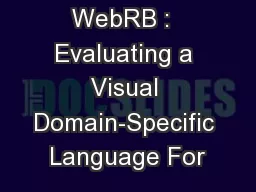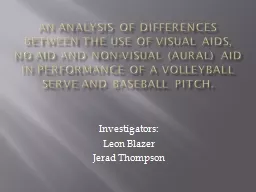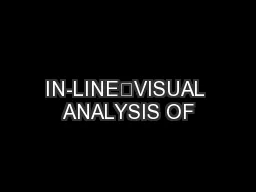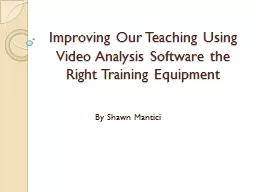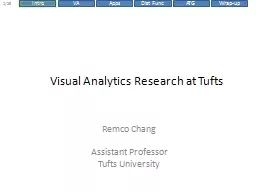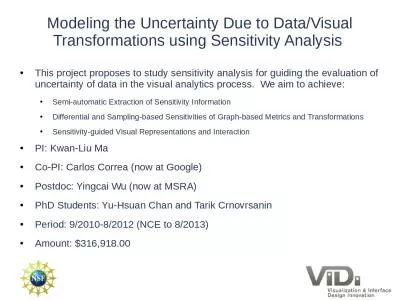PPT-IN-LINE VISUAL ANALYSIS OF
Author : lindy-dunigan | Published Date : 2017-12-03
LUBE OILS FOR SOLIDS AND WATER DETECTION ON A CONTINUAL BASIS Thomas M Canty PE JM Canty Inc Buffalo NY Introduction Fundamentals of a good vision system Illumination
Presentation Embed Code
Download Presentation
Download Presentation The PPT/PDF document "IN-LINE VISUAL ANALYSIS OF" is the property of its rightful owner. Permission is granted to download and print the materials on this website for personal, non-commercial use only, and to display it on your personal computer provided you do not modify the materials and that you retain all copyright notices contained in the materials. By downloading content from our website, you accept the terms of this agreement.
IN-LINE VISUAL ANALYSIS OF: Transcript
LUBE OILS FOR SOLIDS AND WATER DETECTION ON A CONTINUAL BASIS Thomas M Canty PE JM Canty Inc Buffalo NY Introduction Fundamentals of a good vision system Illumination Camera . We specialize in large selection of backyard zip line kits for kids adults. We offer great discounts and free shipping with great service. Browse full range now! Bee Line may use third party providers for certain aspects of the Service the Underlying Providers By using the Service you agree to be bound by the terms and conditions of this Agreement 1 EQUIPMENT a Bee Line Cable Equipment Customer may either re Demystifying Low Vision Reports. MAER. April 27, 2012. Optical Prescription. Distance Visual Acuity. Near Visual Acuity. Oculomotor. Skills. Visual Field. OPTICAL PRESCRIPTION. INTENT AND IMPACT . O.D. +3.50 -1.50 X 180. A Brief Introduction. Adapted from Stephen . Harmon and Stanislav . Rivkin . All Images argue something, just like written rhetoric. But unlike written rhetoric, visual rhetoric may be less straightforward. It might require additional analysis to understand the argument . . FOCAL POINT. Focal Point – The main area of interest in a visual.. Here the baby, who is probably taking her first steps, is the focal point of the picture.. The background (the yard, gate) is noticed after the baby, and as are the people’s arms and limbs. Thus the baby is the main focus of this picture.. Two Examples on . 2016 Presidential Election. Or This. http://. www.nytimes.com/interactive/2016/11/08/us/elections/how-trump-pushed-the-election-map-to-the-right.html. Are They Good Enough to Analyze What Was Going On?. Dr Pat Bennett. Educational Psychologist. Causes of . R. eading Difficulties . - . How many . possible. causes of . potential reading . difficulties can we identify. ?. Poor auditory discrimination?. Building Relational Web-Applications. Avraham . Leff. James T. . Rayfield. IBM T.J. Watson Research Center. {. avraham,jtray. }@us.ibm.com. OOPSLA’07. Presented by David Gonzalez. Key Insights:. Investigators:. Leon Blazer. Jerad. Thompson. SERVING/. PITCHING. ANALYSIS. Purpose:. Analyze current methods of teaching pitching and serving using visual aids. Desired Effects. . Rope placed 14 inches above top tape of net (102 inches from ground. Ziho. Kang. Industrial and Systems Engineering. Research focus. Characterizing eye tracking data through data analysis algorithms. . . E.g. Visual scanning sequence comparison methods, or clustering methods.. . LUBE OILS FOR SOLIDS AND WATER DETECTION ON A CONTINUAL BASIS. Thomas M. Canty, P.E.. J.M. Canty Inc.. Buffalo, NY. Introduction. Fundamentals of a good vision system. . - Illumination. . - Camera . the . R. ight Training Equipment. By Shawn . Mantici. Video analysis software. Improves communication through visual support.. Easy to analyze through visual data.. Easy to share data between student and teacher. . Tufts. Remco. Chang. Assistant Professor. Tufts University. Problem Statement. The growth of data is exceeding our ability to analyze them. . The amount of digital information generated in the years 2002, 2006, 2010:. This project proposes to study sensitivity analysis for guiding the evaluation of uncertainty of data in the visual analytics process. We aim to achieve:. Semi-automatic Extraction of Sensitivity Information.
Download Document
Here is the link to download the presentation.
"IN-LINE VISUAL ANALYSIS OF"The content belongs to its owner. You may download and print it for personal use, without modification, and keep all copyright notices. By downloading, you agree to these terms.
Related Documents

